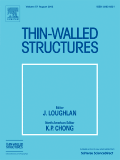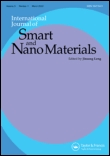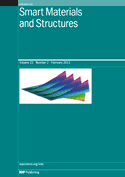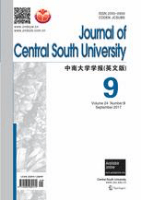
JOURNAL OF INTELLIGENT MATERIAL SYSTEMS AND STRUCTURES
Scope & Guideline
Empowering Insights into Cutting-Edge Material Technologies
Introduction
Aims and Scopes
- Smart Materials Development:
The journal emphasizes the development and characterization of smart materials such as shape memory alloys, magnetorheological fluids, and piezoelectric materials for applications in actuators, sensors, and energy harvesting systems. - Modeling and Simulation Techniques:
A significant focus is placed on advanced modeling and simulation techniques, including finite element analysis, machine learning, and analytical approaches to predict material behavior under various conditions. - Applications in Structural Engineering:
Research on the application of intelligent materials in structural engineering contexts, including seismic protection systems, vibration control, and health monitoring of civil structures. - Energy Harvesting and Conversion:
The journal also covers innovative methods for energy harvesting and conversion using smart materials, exploring their potential in sustainable energy solutions. - Interdisciplinary Approaches:
A unique contribution of the journal is its interdisciplinary approach, merging concepts from physics, materials science, and engineering to advance the understanding of intelligent materials.
Trending and Emerging
- Integration of Machine Learning:
Recent publications highlight a growing trend towards integrating machine learning techniques in the design and optimization of intelligent material systems, enhancing predictive capabilities and performance. - Bio-inspired Materials and Structures:
There is an increasing interest in bio-inspired materials and structures, leveraging nature's designs for enhanced functionality and adaptability in engineering applications. - Sustainable and Eco-friendly Solutions:
Research focusing on sustainable materials and energy-efficient solutions is trending, reflecting a broader societal shift towards environmentally friendly practices in engineering. - Advanced Energy Harvesting Techniques:
Emerging themes include innovative energy harvesting techniques that utilize intelligent materials, showcasing their potential for self-powered systems in various applications. - Smart Health Monitoring Systems:
The journal is seeing a rise in studies related to smart health monitoring systems that utilize intelligent materials for real-time structural health assessment, indicating a trend towards practical applications in civil engineering.
Declining or Waning
- Traditional Materials Research:
There is a noticeable decline in studies focusing solely on traditional materials without intelligent capabilities, as the field shifts towards advanced smart materials that offer enhanced functionalities. - Basic Theoretical Studies:
The journal sees less emphasis on purely theoretical studies without experimental validation or practical application, favoring research that demonstrates real-world applications of intelligent materials. - Static Analysis of Structures:
Research involving static analysis of structures using conventional materials is becoming less frequent, with more interest in dynamic behavior and the application of smart materials in active systems. - Passive Vibration Control Systems:
There is a declining interest in passive vibration control systems, as researchers explore more adaptive and responsive systems utilizing intelligent materials.
Similar Journals

Journal of Structural Integrity and Maintenance
Elevating Standards in Structural Engineering ResearchThe Journal of Structural Integrity and Maintenance, published by Taylor & Francis Ltd, serves as a prestigious platform dedicated to the advancement of knowledge in the fields of structural integrity, civil engineering, and materials science. With an ISSN of 2470-5314 and an E-ISSN of 2470-5322, this journal is uniquely positioned to address the critical challenges faced by researchers and professionals in building and construction, mechanical engineering, and related domains. Since its inception in 2016, this journal has been consistently recognized for its quality, currently holding a Q2 rank across several disciplines, including Building and Construction and Civil and Structural Engineering in 2023. The journal aims to publish high-quality research that contributes to the understanding and maintenance of structural integrity, fostering innovations that promote safety, efficiency, and sustainability in engineering practices. Researchers and students alike are encouraged to engage with this rich repository of knowledge, which plays a vital role in shaping future advancements in structural engineering and materials science.

THIN-WALLED STRUCTURES
Advancing the Future of Structural IntegrityTHIN-WALLED STRUCTURES is a premier international journal published by Elsevier Science Ltd, focusing on the critical areas of Building and Construction, Civil and Structural Engineering, and Mechanical Engineering. With an impressive impact factor and categorization in the Q1 quartile of each respective field, this journal stands at the forefront of engineering research, boasting commendable Scopus rankings—52nd for Mechanical Engineering, 18th for Building and Construction, and 32nd for Civil and Structural Engineering. Since its inception in 1983, THIN-WALLED STRUCTURES has provided a vital platform for disseminating innovative research, practical applications, and theoretical advancements in thin-walled structures, encouraging the development of safer and more efficient design methodologies. Although it operates on a traditional access model, the journal is committed to maintaining high-quality peer review and publishing, making it an essential resource for researchers, professionals, and students aiming to contribute to and benefit from the latest advancements in this dynamic field.

International Journal of Smart and Nano Materials
Innovating with Smart Solutions and Nano TechnologiesThe International Journal of Smart and Nano Materials is a leading peer-reviewed publication in the fields of civil and structural engineering, mechanics of materials, and materials science, published by Taylor & Francis Ltd. With its notable Open Access format since 2010, this journal aims to disseminate innovative research and advancements in smart materials and nano technologies, which are crucial for the development of sustainable and efficient engineering solutions. The journal has established a strong reputation, being classified in the Q1 category for Civil and Structural Engineering and Mechanics of Materials, and ranked highly in Scopus with impressive percentiles, illustrating its impact within the academic community. Covering research from 2010 to 2024, it serves as an essential resource for researchers, professionals, and students seeking to stay at the forefront of material innovation and engineering prowess. Current access options facilitate the broad distribution of knowledge, reflecting the journal's commitment to advancing scientific inquiry and application in an increasingly nanotechnology-driven world.

Smart Materials and Structures
Fostering Collaboration for Smart Material AdvancementsSmart Materials and Structures, published by IOP Publishing Ltd, is a leading journal in the realms of engineering and physics, with an impressive reputation for disseminating transformative research relevant to Atomic and Molecular Physics, Civil and Structural Engineering, Condensed Matter Physics, Electrical and Electronic Engineering, and Materials Science. Since its inception in 1992, this journal has become a cornerstone in the study of innovative materials and their potential applications in various domains. With a remarkable impact reflected in its Q1 rankings across multiple categories for 2023 and its notable Scopus standings, Smart Materials and Structures serves as an essential platform for scholars and practitioners aiming to stay at the forefront of material science advancements. Although the journal operates under traditional access, it ensures that critical findings and methodologies in smart materials are readily available to a global audience, fostering collaboration and innovation in technology and engineering. Respected for its rigorous peer-review process, the journal encourages submissions that present original research, review articles, and significant case studies that can lead to groundbreaking developments in smart material applications.

International Journal of Multiphysics
Connecting Theory and Application in MultiphysicsWelcome to the International Journal of Multiphysics, a pioneering platform dedicated to the expansive field of multiphysics and its applications across various engineering disciplines. Published by MULTI-SCIENCE PUBL CO LTD since 2007, this Open Access journal plays a crucial role in disseminating innovative research findings that advance our understanding of complex interactions in multiphysical phenomena. With its ISSN 1750-9548, the journal has made significant contributions within its converged years from 2010 to 2024, offering insights into Computational Mechanics, Fluid Flow, Mechanical Materials, and Numerical Analysis with a current classification in the Q4 Quartile across multiple relevant categories. Researchers, professionals, and students will find valuable information and cutting-edge studies by accessing the journal from the United Kingdom, and thus contribute to ongoing dialogues in these critical areas of study. The International Journal of Multiphysics represents an essential resource for those aiming to innovate and enhance our knowledge of interactive systems in engineering and applied sciences.

Journal of Central South University
Connecting Research and Practical Applications in MetalsThe Journal of Central South University, with ISSN 2095-2899 and E-ISSN 2227-5223, stands as a leading publication in the fields of Engineering and Materials Science, particularly in Metals and Alloys. Published by JOURNAL OF CENTRAL SOUTH UNIV, this journal has established itself as a vital source of innovative research and technical advancements, emphasizing interdisciplinary approaches and practical applications. With an impressive Q1 ranking in both Engineering (miscellaneous) and Metals and Alloys for 2023, it is recognized for its high-impact contributions, reflected in its rankings of Rank #52/307 in General Engineering and Rank #35/176 in Metals and Alloys within Scopus. The journal aims to disseminate cutting-edge research findings and insightful discussions, making it an essential resource for researchers, professionals, and students keen on advancing their knowledge in these dynamic fields. Although it is not open access, the journal's reach and reputation ensure that its contents are accessible to a broad academic audience interested in the significant developments shaping the future of engineering and materials science.

Smart Structures and Systems
Leading the Charge in Structural InnovationSmart Structures and Systems is an esteemed academic journal published by TECHNO-PRESS, focusing on cutting-edge research in the fields of computer science applications, control and systems engineering, and electrical and electronic engineering. With its high standing reflected in a 2023 Q2 ranking across multiple categories, this journal provides an influential platform for disseminating innovative ideas and methodologies that are transforming smart technologies. The journal's commitment to quality research is underscored by its impressive Scopus rankings, placing it in the 75th percentile and above within its respective fields. Although Smart Structures and Systems does not have an Open Access model, it remains an essential resource for researchers, professionals, and students alike, facilitating scholarly discourse and advancing knowledge in smart systems. Addressed from its headquarters in South Korea, the journal continues to bridge gaps between academia and industry, making significant contributions to the global arena in smart structural technologies.

APPLIED MATHEMATICS AND MECHANICS-ENGLISH EDITION
Connecting Mathematical Theory to Real-World ChallengesApplied Mathematics and Mechanics - English Edition is a prestigious journal published by Shanghai University, focusing on the interdisciplinary applications of mathematics and mechanics across various scientific and engineering domains. With an ISSN of 0253-4827 and an E-ISSN of 1573-2754, this journal has established itself as a vital resource since its inception in 1980, extending its coverage well into 2024. The journal boasts impressive Scopus rankings—placing it in the top 10% of the Applied Mathematics category and the top 20% in Mechanical Engineering and Mechanics of Materials—reflecting its significant impact and contribution to research. Currently categorized in the Q2 and Q1 quartiles, it caters to a diverse audience that includes researchers, professionals, and students seeking to explore cutting-edge developments and innovative methodologies in the field. Although the journal is not open access, it remains committed to disseminating high-quality research that addresses contemporary challenges in applied mathematics and mechanics, fostering a deeper understanding of their practical implications.

Applications in Engineering Science
Unlocking Insights in Civil, Mechanical, and Computational EngineeringApplications in Engineering Science is an innovative and highly-regarded open-access journal, published by ELSEVIER in the United Kingdom, focusing on the cross-disciplinary fields of Civil and Structural Engineering, Computational Mechanics, and Mechanical Engineering. Since its inception in 2020, the journal has rapidly established a solid reputation, landing in the Q2 quartile category across multiple engineering disciplines, reflecting its commitment to quality and relevance in the rapidly evolving engineering landscape. With Scopus rankings placing it prominently in the 66th percentile for Computational Mechanics and 58th for Mechanical Engineering, it serves as a vital platform for researchers, professionals, and students alike to share advanced methodologies, innovative applications, and interdisciplinary insights. The journal is committed to fostering open access to cutting-edge research, empowering readers worldwide to stay abreast of significant technological advancements and practical applications in engineering science.

ACS Materials Letters
Pioneering Discoveries in Chemical Engineering and BeyondACS Materials Letters is an esteemed peer-reviewed journal published by the American Chemical Society, emphasizing groundbreaking research and advancements in the fields of materials science, biomedical engineering, and chemical engineering. With a robust update and established reputation since its inception in 2019, this journal has rapidly ascended to the top tiers, achieving Q1 rankings in key categories such as Biomedical Engineering, Chemical Engineering (miscellaneous), and Materials Science (miscellaneous) in 2023. The journal boasts impressive Scopus rankings, including #14 in General Chemical Engineering and #19 in Biomedical Engineering, placing it among the elite publications in these domains. While not fully open access, ACS Materials Letters facilitates the dissemination of high-impact research accessible to academics and industry professionals alike. With its comprehensive scope and rigorous selection process, the journal serves as a vital resource for researchers and students eager to stay abreast of the latest innovations and technologies shaping materials science and engineering.